- nautilus
- steam engine
- steamboat
Basic Information
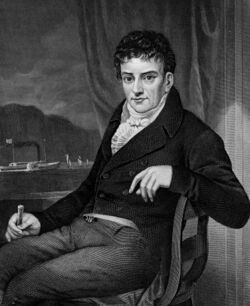
(Nov 1765–Feb 1815)
Location: Little Britain, Lancaster County, Province of Pennsylvania, British America
1. Introduction
Robert Fulton (November 14, 1765 – February 25, 1815) was an United States engineer and inventor who is widely credited with developing a commercially successful steamboat; the first was called The North River Steamboat of Clermonts. In 1807 that steamboat traveled on the Hudson River with passengers from New York City to Albany and back again, a round trip of 300 miles, in 62 hours. The success of his steamboat changed river traffic and trade on major American rivers.
In 1800, Fulton had been commissioned by Napoleon Bonaparte, leader of France, to attempt to design a submarine; he produced the Nautilus, the first practical submarine in history.[1] Fulton is also credited with inventing some of the world's earliest naval torpedoes for use by the British Royal Navy.[2]
Fulton became interested in steam engines and the idea of steamboats in 1777 when he was around age 12 and visited state delegate William Henry of Lancaster, Pennsylvania, who was interested in this topic. Henry had learned about inventor James Watt and his Watt steam engine on an earlier visit to England .
2. Early Life and Family
Robert Fulton was born on a farm in Little Britain, Pennsylvania, on November 14, 1765. He had three sisters – Isabella, Elizabeth, and Mary, and a younger brother, Abraham. Fulton's father, Robert, had been a close friend of the father of painter Benjamin West. The younger Fulton later met West in England and they became friends.[3]
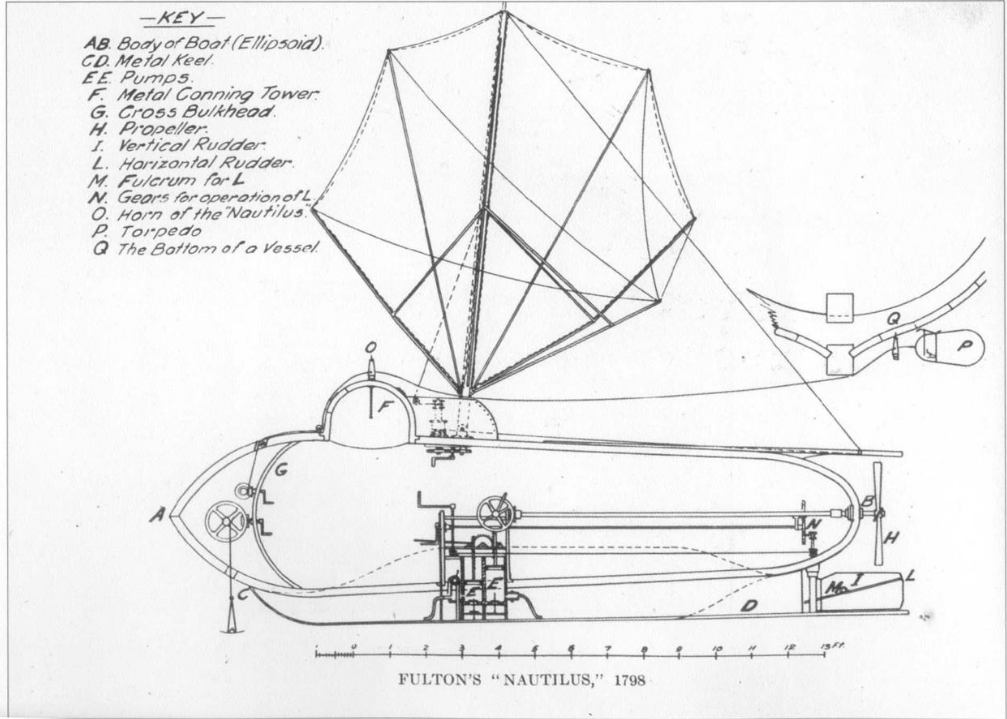
Fulton stayed in Philadelphia for six years, where he painted portraits and landscapes, drew houses and machinery, and was able to send money home to help support his mother. In 1785 he bought a farm at Hopewell Township in Washington County for £80 Sterling and moved his mother and family into it. While in Philadelphia, he met a number of prominent figures in the city, including Benjamin Franklin (1705/1706-1790). He was known for both his political and writing abilities and his scientific and inventing knowledge. At the age of 23, Fulton decided to visit Europe.
On January 8, 1808, Fulton married Harriet Livingston (1786–1824), the daughter of Walter Livingston and niece of Robert Livingston, prominent men in the Hudson River area, whose family dated to the colonial era.[4][5] They had four children: Robert, Julia, Mary, and Cornelia.[5]
3. Work
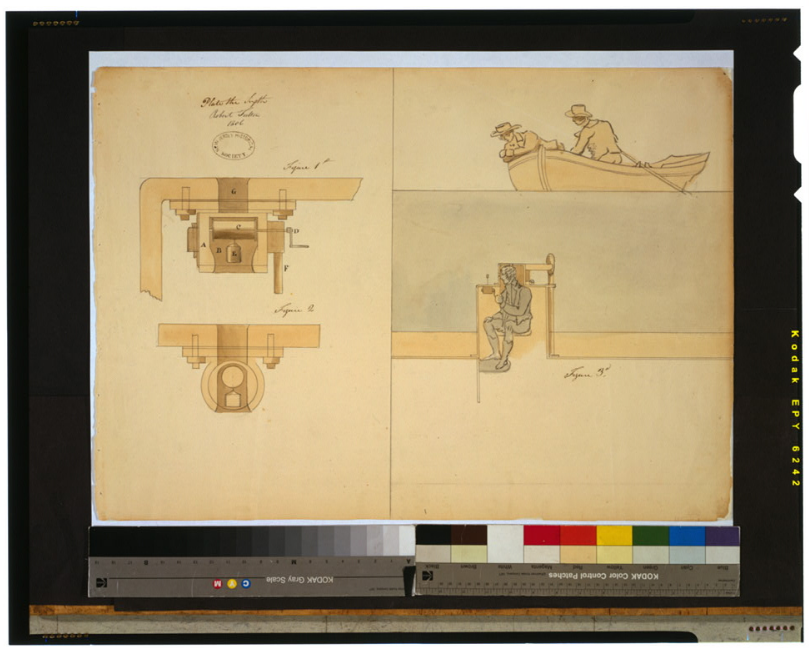
Fulton went to England in 1786, carrying several letters of introduction to Americans abroad from the individuals he had met in Philadelphia. He had already corresponded with artist Benjamin West, and West took Fulton into his home, where Fulton lived for several years. Fulton gained many commissions painting portraits and landscapes, which allowed him to support himself. He continued to experiment with mechanical inventions.[3]
Fulton became caught up in the enthusiasm of the "Canal Mania". In 1793 he began developing his ideas for tub-boat canals with inclined planes instead of locks. He obtained a patent for this idea in 1794 and also began working on ideas for the steam power of boats. He published a pamphlet about canals and patented a dredging machine and several other inventions. In 1794 he moved to Manchester to gain practical knowledge of English canal engineering. While there he became friendly with Robert Owen, a cotton manufacturer and early socialist. Owen agreed to finance the development and promotion of Fulton's designs for inclined planes and earth-digging machines; he was instrumental in introducing the American to a canal company, which awarded him a sub-contract. But Fulton was not successful at this practical effort and he gave up the contract after a short time.[6]
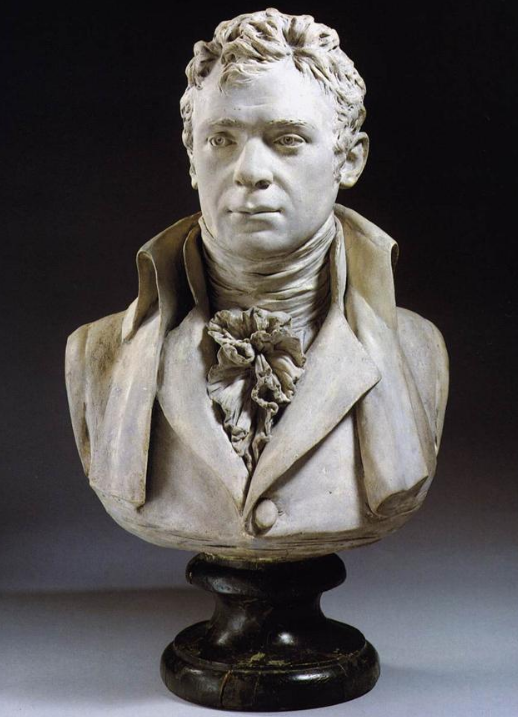
In 1797 Fulton went to Paris, where his fame as an inventor was well known. This city and London were the scientific centers of the 18th-century European world. There Fulton studied French and German, along with mathematics and chemistry. He began to design torpedoes and submarines. In Paris, Fulton met James Rumsey, who sat for a portrait in West's studio, where Fulton was an apprentice. Rumsey was an inventor from Virginia, who in 1786 ran his own first steamboat up the Potomac River nearly as far as Shepherdstown, then in Virginia (now West Virginia).
As early as 1793, Fulton proposed plans for steam-powered vessels to both the United States and British governments. In England he met the Duke of Bridgewater Francis Egerton, whose canal, the first to be constructed in Britain, was being used for trials of a steam tug. Fulton became very enthusiastic about the canals. In 1796 he wrote a treatise on canal construction, suggesting improvements to locks and other features.
Working for the Duke of Bridgewater between 1796 and 1799, Fulton had a boat constructed in the Duke's timber yard, under the supervision of Benjamin Powell. After installation of the machinery supplied by the engineers Bateman and Sherratt of Salford, the boat was duly christened Bonaparte in honour of Fulton having served under Napoleon. After expensive trials, because of the configuration of the design, the team feared the paddles might damage the clay lining of the canal and eventually abandoned the experiment. In 1801 the Duke, impressed by Charlotte Dundas, constructed by William Symington, decided to order eight of such vessels for his canal. After he died in 1803, the estate executor cancelled the order. Symington had successfully tried steamboats in 1788, and it seems probable that Fulton was aware of these developments.
The first successful trial run of a steamboat had been made several years earlier in the United States by inventor John Fitch, on the Delaware River on August 22, 1787. Attendees included delegates from the Constitutional Convention, who were observing while taking a break from their summer-long sessions at Independence Hall. The steamboat was propelled by a bank of oars on either side of the boat. The following year Fitch launched a 60-foot (18 m) boat powered by a steam engine driving several stern-mounted oars. These oars paddled in a manner similar to the motion of a swimming duck's feet. With this boat he carried up to thirty passengers for hire on numerous round-trip voyages on the Delaware River between Philadelphia and Burlington, New Jersey.
Fitch was granted a patent on August 26, 1791, after a battle with Rumsey, who had created a similar invention. The newly created Patent Commission did not award the broad monopoly patent that Fitch had asked for, but a patent of the modern kind, for the new design of Fitch's steamboat. It also awarded patents to Rumsey and John Stevens for their steamboat designs. The loss of a monopoly caused many of Fitch's investors to leave his company. While his boats were mechanically successful, Fitch failed to pay sufficient attention to construction and operating costs, and he was unable to justify the economic benefits of steam navigation. But decades later, Fulton developed Fitch's concept into a wildly profitable business proposition.
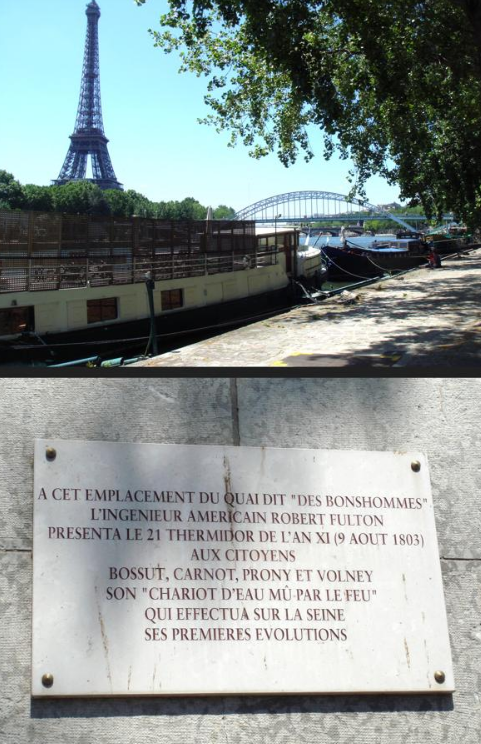
In 1797, Fulton went to France, where Claude de Jouffroy had made a working paddle steamer in 1783. He began experimenting with submarine torpedoes and torpedo boats. Fulton also exhibited the first panorama painting to be shown in Paris: Vue de Paris depuis les Tuilerie (1800), painted by Pierre Prévost, Jean Mouchet, and Denis Fontaine. The street where this panorama was shown is still called "Rue des Panoramas" (Panorama Street) today.[7]
While living in France, Fulton designed the first working submarine, Nautilus, between 1793 and 1797. When tested, his submarine operated underwater for 17 minutes in 25 feet of water. He asked the government to subsidize its construction, but he was turned down twice. Eventually he approached the Minister of Marine and in 1800 was granted permission to build.[8] The shipyard Perrier in Rouen built it, and the submarine sailed first in July 1800 on the Seine River in the same city.
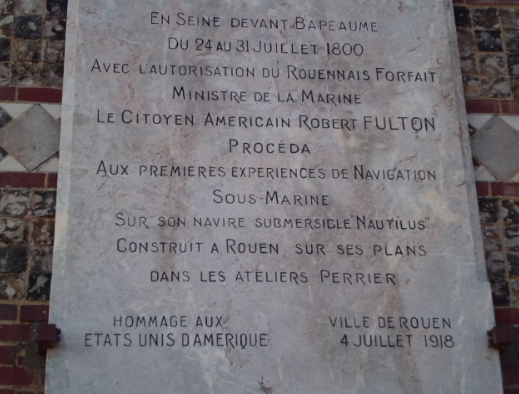
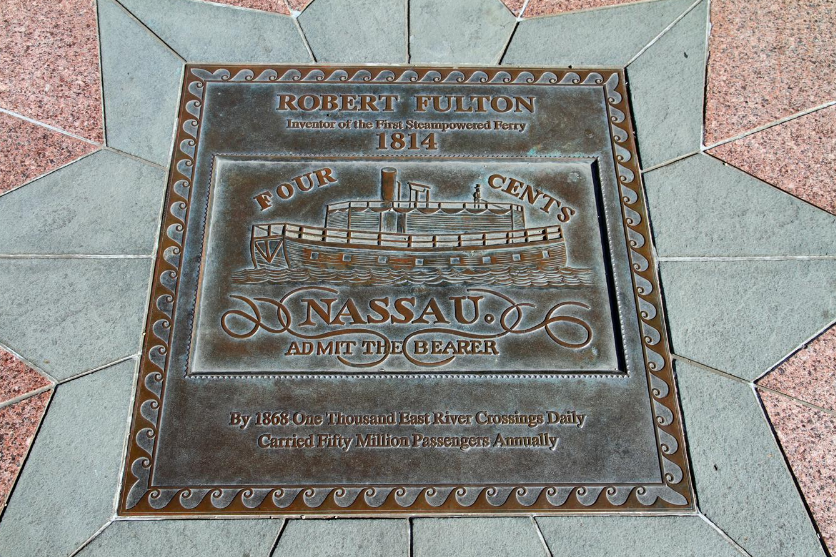
In France, Fulton met Robert R. Livingston, who was appointed as U.S. Ambassador to France in 1801. He also had a scientifically curious mind, and the two men decided to collaborate on building a steamboat and to try operating it on the Seine. Fulton experimented with the water resistance of various hull shapes, made drawings and models, and had a steamboat constructed. At the first trial the boat ran perfectly, but the hull was later rebuilt and strengthened. On August 9, 1803, when this boat was driven up the River Seine, it sank. The boat was 66 feet (20.1 m) long, 8 feet (2.4 m) beam, and made between 3 and 4 miles per hour (4.8 and 6.4 km/h) against the current.
In 1804, Fulton switched allegiance and moved to England, where he was commissioned by Prime Minister William Pitt the Younger to build a range of weapons for use by the Royal Navy during Napoleon's invasion scares. Among his inventions were the world's first modern naval "torpedoes" (modern "mines"). These were tested, along with several other of his inventions, during the 1804 Raid on Boulogne, but met with limited success. Although Fulton continued to develop his inventions with the British until 1806, the decisive naval victory by Admiral Horatio Nelson at the 1805 Battle of Trafalgar greatly reduced the risk of French invasion. Fulton was increasingly ignored.[2]
In 1806, Fulton returned to the United States. In 1807, he and Robert R. Livingston built the first commercially successful steamboat, North River Steamboat (later known as Clermont). Livingston's shipping company began using it to carry passengers between New York City and up the Hudson River to the state capital Albany. The Clermont made the 150-mile trip in 32 hours. Passengers on the maiden voyage included a lawyer Jones and his family from Bethlehem, Pennsylvania. His infant daughter Alexandra Jones later served as a Union nurse on a steamboat hospital in the Civil War.[9]
From 1811 until his death, Fulton was a member of the Erie Canal Commission, appointed by the Governor of New York.
Fulton's final design was the floating battery Demologos. This first steam-driven warship in the world was built for the United States Navy for the War of 1812. The heavy vessel was not completed until after Fulton's death and was named for him in his honor.
From October 1811 to January 1812, Fulton, along with Livingston and Nicholas Roosevelt (1767-1854), worked together on a joint project to build a new steamboat New Orleans, sturdy enough to take down the Ohio and Mississippi rivers to New Orleans, Louisiana. It traveled from Pittsburgh, Pennsylvania, with stops at Wheeling, Virginia; Cincinnati, Ohio; past the "Falls of the Ohio" at Louisville, Kentucky; to near Cairo, Illinois and the confluence with the Mississippi River; past St. Louis and down past Memphis, Tennessee and Natchez, Mississippi to New Orleans on the Gulf of Mexico coast. This was less than a decade after the United States had acquired the Louisiana Territory from France . These rivers were not well settled, mapped or protected. By achieving this first breakthrough voyage and also proving the ability of the steamboat to travel upstream against powerful river currents, Fulton changed the entire trade and transportation outlook for the American heartland.
Fulton was elected a member of the American Antiquarian Society in 1814.[10]
Fulton died in 1815 in New York City from tuberculosis (then known as "consumption"). He had been walking home on the frozen Hudson River when one of his friends, Addis Emmet, fell through the ice. In the attempt to rescue his friend, Fulton got soaked with icy water. He is believed to have contracted pneumonia. When he got home, his sickness worsened. He was diagnosed with consumption and died at 49 years old.
He is buried in the Trinity Church Cemetery for Trinity Church (Episcopal) at Wall Street in New York City, near other notable Americans such as former U.S. Secretaries of the Treasury, Alexander Hamilton and Albert Gallatin. His descendants include Cory Lidle, a former Major League Baseball pitcher.[11]
4. Posthumous Honors
The Commonwealth of Pennsylvania donated a marble statue of Fulton to the National Statuary Hall Collection in the United States Capitol. Fulton was also honored for his development of steamship technology in New York City's Hudson-Fulton Celebration of the Centennial in 1909. A replica of his first steam-powered steam vessel, Claremont, was built for the occasion.
Many places in the U.S. are named for Robert Fulton, including:
- Fulton Township, Lancaster County, Pennsylvania
- Fulton Elementary School, Fulton Township, Lancaster County, Pennsylvania[12]
- Fulton Steamboat Inn, hotel in Lancaster County, Pennsylvania
- Robert Fulton School, Philadelphia
- Fulton Elementary School, Dubuque, Iowa
- Robert Fulton Fire Company, Fulton Township, Lancaster County, Pennsylvania
- Robert Fulton Highway, Lancaster County, Pennsylvania
- Fulton Opera House, Lancaster, Pennsylvania
- Robert Fulton Drive in Columbia, Howard County, Maryland
- Robert Fulton Drive in Reston, Virginia
- Fulton Avenue in Sacramento, California
- Fulton Neighborhood in Minneapolis, Minnesota
- Fulton-Randolph Market District
- Fulton Street in Brooklyn, New York City
- BMT Fulton Street Line subway line
- IND Fulton Street Line subway line
- Fulton Street (IND Crosstown Line)
- Fulton Street in Manhattan
- Fulton Center in Manhattan
- Fulton Street (New York City Subway) subway station
- Fulton Fish Market
- Fulton Street in Massapequa Park, New York
- Fulton Street in New Orleans, Louisiana
- Fulton Street in Alcoa, Tennessee
- Fulton Street in San Francisco , California
- Fulton Street in Anaheim, California
- Fulton County, Ohio
- Fulton County, Indiana
- Fulton County, Kentucky
- Fulton County, Illinois
- Fulton County, Pennsylvania
- Fulton County, New York
- Fulton County, Georgia[13], partially home to the state capital, Atlanta
- Fulton, Mississippi
- Fulton, Missouri[14]
- Fulton, Arkansas
- Fulton, Oswego County, New York
- Fulton, Schoharie County, New York
- Fulton Chain Lakes, New York
- Fultonham, Ohio
- Fultonville, New York
- Fulton Hall, State Quad, University at Albany, (State University of New York at Albany)
- Fulton Park, New York City
Five ships of the United States Navy have borne the name "USS Fulton" in honor of Robert Fulton.
Fulton Hall at the United States Merchant Marine Academy houses the Department of Marine Engineering and included laboratories for diesel and steam engineering, refrigeration, marine engineering, thermodynamics, materials testing, machine shop, mechanical engineering, welding, electrical machinery, control systems, electric circuits, engine room simulators and graphics.
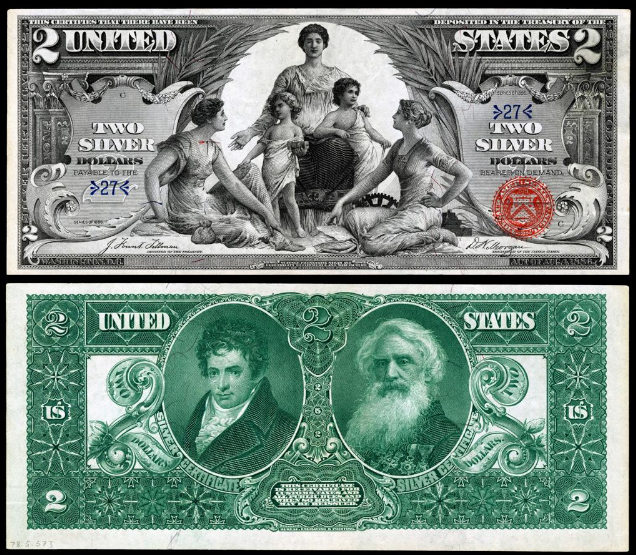
Bronze statues of Fulton and Christopher Columbus represent commerce on the balustrade of the galleries of the Main Reading Room in the Thomas Jefferson Building of the Library of Congress on Capitol Hill in Washington, D.C. They are two of 16 historical figures, each pair representing one of the 8 pillars of civilization.
The Guatemalan government in 1910 erected a bust of Fulton in one of the parks of Guatemala City.[15]
In 2006, he was inducted into the "National Inventors Hall of Fame" in Alexandria, Virginia.[16]
4.1. In Popular Culture
Referenced in The Phil Silvers Show. In Episode 19 of Series 1 titled "The Revolutionary War", a soldier bought 4 tickets to his birthday ball. The show aired on Jan 24 1956.
A probably largely fictionalised account of Fulton's role was produced by BBC television. In the first serial, Triton (1961, re-made in 1968), two British naval officers, Captain Belwether and Lieutenant Lamb, are involved in spying on Fulton while he is working for the French. In the second serial, Pegasus (1969), they are surprised to find themselves working with him after he changed sides.
20th Century-Fox in 1940 released the film Little Old New York, a highly fictional telling of Fulton's life from his arrival in New York to the first sailing of Claremont. British actor Richard Greene stars as Fulton with Brenda Joyce as Harriet Livingston. Much attention is given to Alice Faye and Fred MacMurray as wharf friends who help Fulton realize his dream amid problem after problem. It was based on a play by Rida Johnson Young. The views of an 1807 New York harbor are particularly elaborate and convincing.
In the children's TV series "TUGS" a steam powered ferry is named Fulton Ferry, named after the Fulton Ferry Company, founded by Fulton in 1814.
A Robert Fulton cartoon character appears in Casper the Friendly Ghost short film titled "Red, White, and Boo."
Author James McGee used Fulton's experiments in early submarine warfare (against wooden warships) as a major plot element in his novel "Ratcatcher".
"Invasion", ISBN:9780340961155, the tenth novel in Kydd, early 19th Century/"Napoleonic Wars" naval warfare series by Julian Stockwin, also uses Fulton and his submarine as an important plot element.
In the George and Ira Gershwin song, "They All Laughed", in a listing of concepts the public initially thought of as folly, "Fulton and his steamboat, Hershey and his chocolate bar" are cited.
Additionally, he is referenced in The Beach Boys rock group song "Steamboat" (Dennis Wilson/Jack Rieley) from the 1973 record album "Holland".
In The Simpsons television series episode, "The Wettest Stories Ever Told", when Marge, playing a Tahitian ruler, mentions Fulton in the line, "Tell me, has Robert Fulton invented the steamboat yet?" as they have no communication with the outside world, Jimbo's character replies "Any day now", referring to Fulton's "Claremont", ironically and erroneously suggesting that news of Fulton's invention has actually reached her and others already, despite his steamboat not being invented until 1807.
Disney Springs at Walt Disney World had a restaurant named Fulton's Crab House with a building in the shape of a steamboat. The restaurant closed for renovation in early 2016 [17]and reopened in February 2017 under the name Paddlefish.[18]
5. Gallery
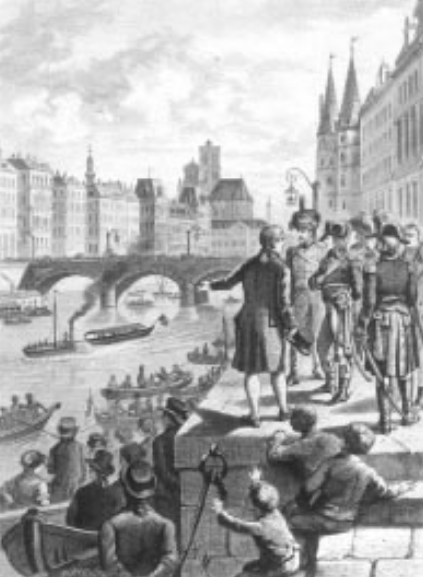
Fulton presents his steamship to Bonaparte in 1803.https://handwiki.org/wiki/index.php?curid=1321254
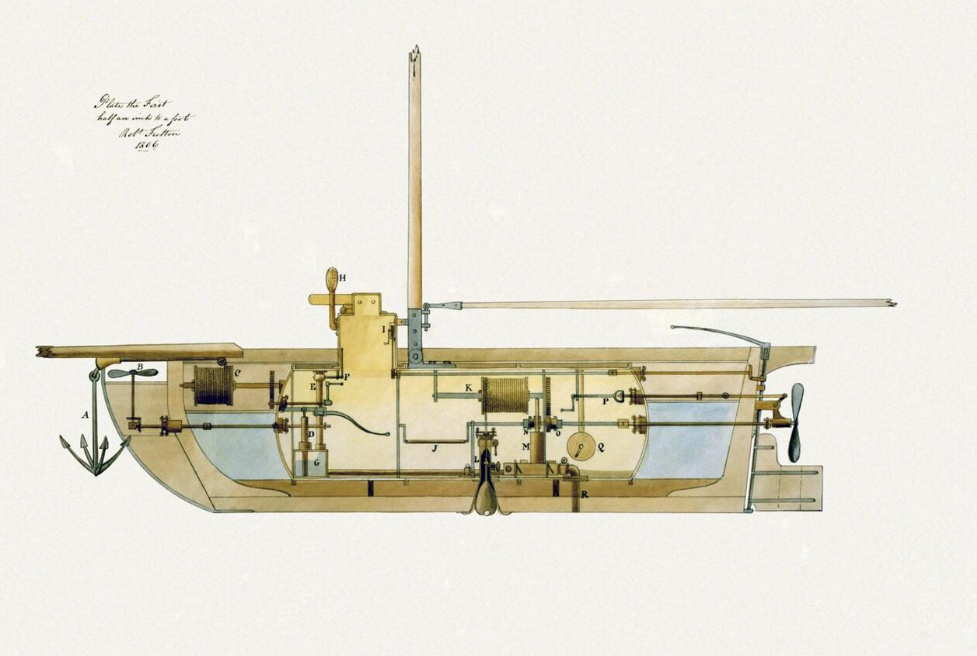
Submarine design in cross section by Robert Fulton, 1806. https://handwiki.org/wiki/index.php?curid=1569434
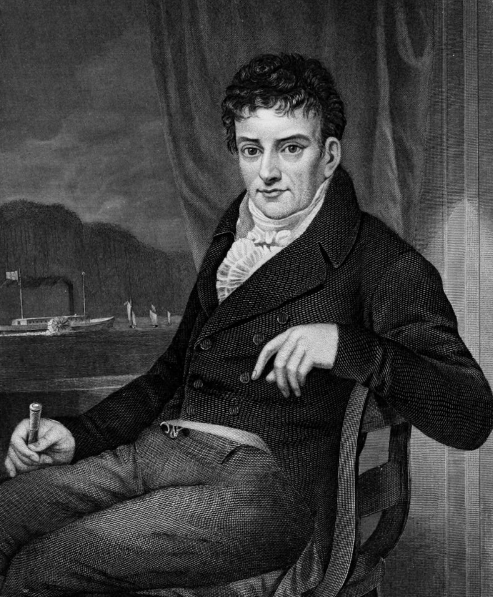
Portrait. https://handwiki.org/wiki/index.php?curid=1632649
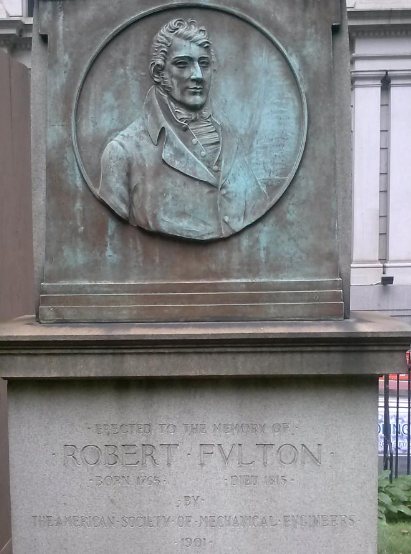
Robert Fulton's tombstone at Trinity Church (Episcopal) in New York City. https://handwiki.org/wiki/index.php?curid=1484638
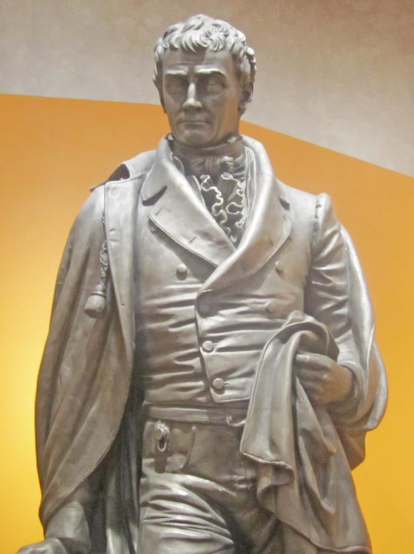
Fulton sculpture by Caspar Buberl at the Brooklyn Museum, 1872. https://handwiki.org/wiki/index.php?curid=1388733
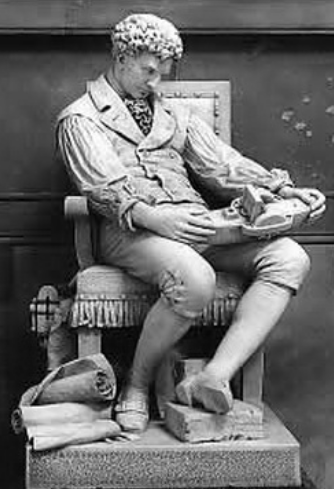
The marble statue by Howard Roberts in Statuary Hall of the United States Capitol, 1878-83. https://handwiki.org/wiki/index.php?curid=1359510
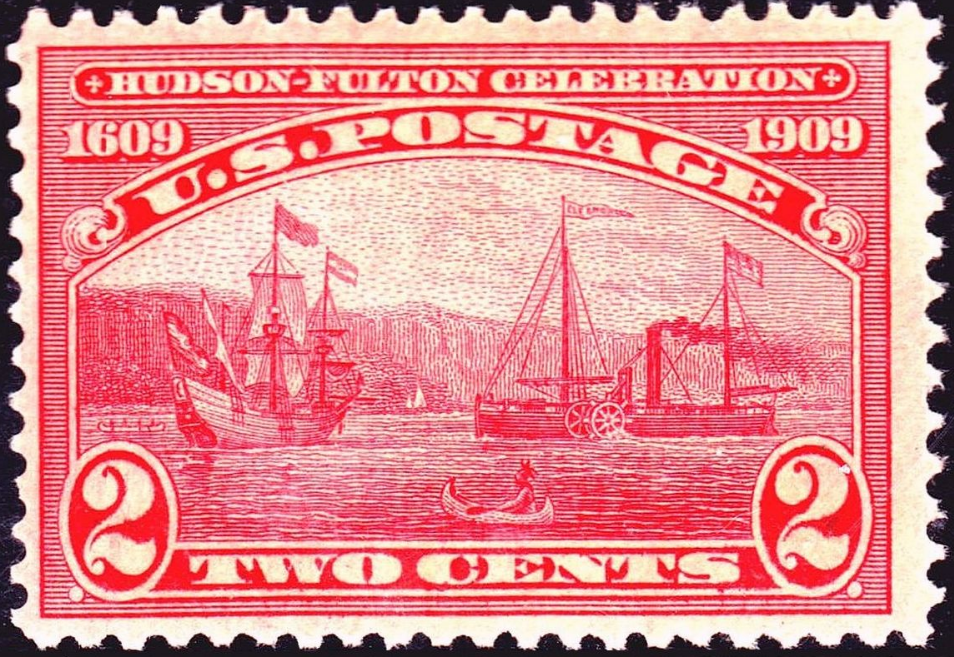
Hudson-Fulton Celebration commemorative stamp, 1909 issue. https://handwiki.org/wiki/index.php?curid=1371929
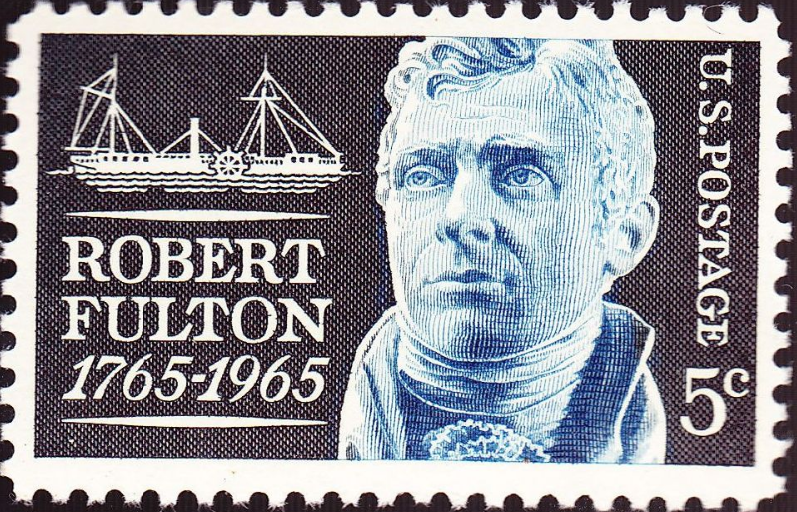
200th Anniversary commemorative stamp, 1965 issue, based on the Houdon bust. https://handwiki.org/wiki/index.php?curid=1261538
6. Publications
- Torpedo war, and submarine explosions published 1810.
- A Treatise on the Improvement of Canal Navigation, 1796. From the University of Georgia Libraries in DjVu & layered PDF formats.
- A Treatise on the Improvement of Canal Navigation 1796. From Rare Book Room.
The content is sourced from: https://handwiki.org/wiki/Biography:Robert_Fulton
References
- American Treasures of the Library of Congress: "Fulton's Submarine" https://www.loc.gov/exhibits/treasures/trr024.html
- Best, Nicholas (2005). Trafalgar: The Untold Story of the Greatest Sea Battle in History. London: Phoenix. ISBN:0-7538-2095-1.
- Buckman, David Lear (1907). Old Steamboat Days on The Hudson River. The Grafton Press. http://www.hrmm.org/diglib/oldsteam/chapter1.html.
- Reynolds, Cuyler (1911). Hudson-Mohawk Genealogical and Family Memoirs: A Record of Achievements of the People of the Hudson and Mohawk Valleys in New York State, Included Within the Present Counties of Albany, Rensselaer, Washington, Saratoga, Montgomery, Fulton, Schenectady, Columbia and Greene. Lewis Historical Publishing Company. pp. 302–303. https://books.google.com/books?id=b4k-AAAAYAAJ&pg=PA302.
- Historical Papers and Addresses of the Lancaster County Historical Society. 1909. pp. 227–228. https://books.google.com/books?id=PP47AAAAIAAJ&pg=PA227.
- Graham Boyes, The Peak Forest Canal, ISBN:9780901461 59 9
- Alice Crary Sutcliffe, Robert Fulton and the 'Clermont' , page 63 [1].
- Burgess, Robert Forrest (1975). Ships Beneath the Sea. McGraw-Hill. ISBN 978-0-07-008958-7. http://www.google.ca/books?id=fDZUAAAAMAAJ&pgis=1.
- Alice Crary Sutcliffe, Robert Fulton and the 'Claremont'
- "MemberListF". American Antiquarian Society. http://www.americanantiquarian.org/memberlistf.
- "Lidle dies after plane crashes into NYC high-rise". ESPN.com. http://sports.espn.go.com/mlb/news/story?id=2621860.
- "The School District of Lancaster". http://www.lancaster.k12.pa.us/elementary/fulton/.
- Garrett, Franklin (1969). Atlanta and Environs: A Chronicle of Its People and Events, 1820s-1870s. Athens, GA: University of Georgia Press. p. 362. ISBN 0-8203-0263-5.
- Eaton, David Wolfe (1916). How Missouri Counties, Towns and Streams Were Named. The State Historical Society of Missouri. pp. 267. https://books.google.com/books?id=RfAuAAAAYAAJ&pg=PA267#v=onepage&q&f=false.
- "Fleet of Fifty Warships Built in the Brooklyn Navy Yard". The Brooklyn Daily Eagle (Brooklyn, New York). 12 May 1910. p. 22. https://www.newspapers.com/image/55387548/. Retrieved 16 August 2018.
- National Inventors Hall of Fame http://www.invent.org/hall_of_fame/268.html
- Arnold, Kyle. "Fulton's Crab House at Disney Springs changing to Paddlefish" (in en-US). OrlandoSentinel.com. http://www.orlandosentinel.com/travel/attractions/the-daily-disney/os-fultons-crabhouse-paddlefish-20160425-story.html.
- Delgado, Lauren. "First Look: Paddlefish in Disney Springs" (in en-US). OrlandoSentinel.com. http://www.orlandosentinel.com/travel/attractions/the-daily-disney/os-et-paddlefish-disney-springs-20170203-story.html.
